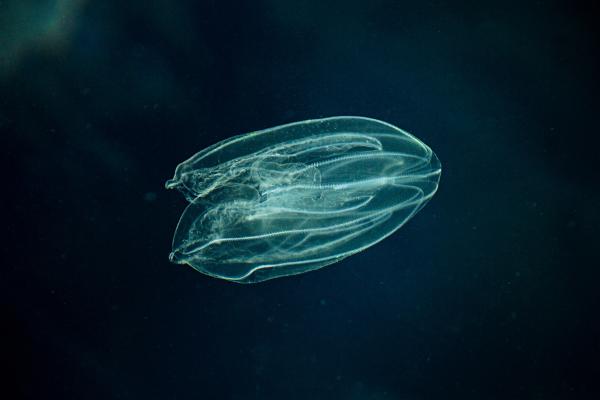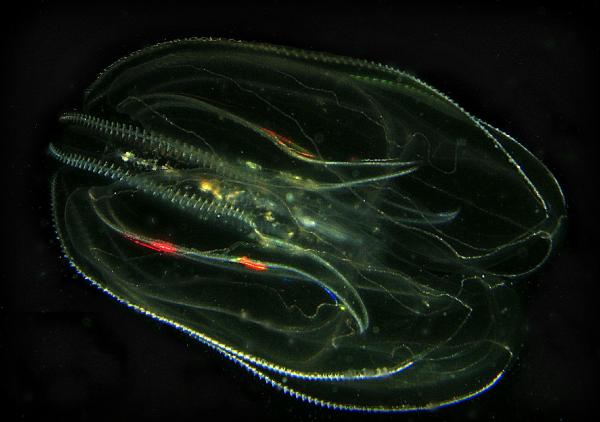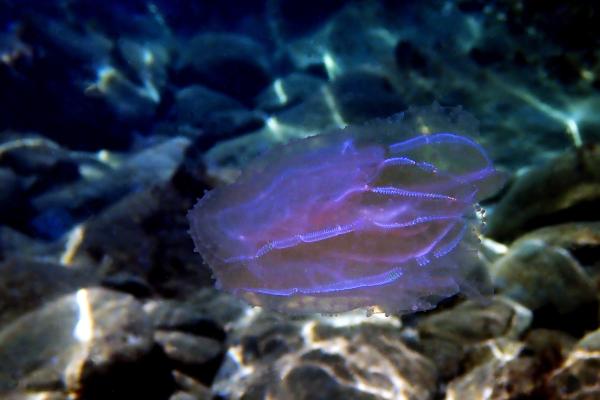Comb jellies (Mnemiopsis leidyi) are mesmerizing marine invertebrates from the phylum Ctenophora, known for their transparent, gelatinous bodies and their ability to swim using rows of tiny hair-like structures called cilia. Scientific evidence suggests that comb jellies emerged around 700 million years ago, potentially making them the earliest animals to appear on Earth, even preceding sponges.

Comb jellies are bioluminescent, translucent creatures measuring up to 10 cm in length. They swim using eight rows of ciliary plates, and emit blue or green light as a defense mechanism. Structurally, they are diploblastic, having two germ layers (ectoderm and endoderm), with a gelatinous mesoglea in between.
Unlike cnidarian jellyfish, they lack stinging cells. Instead, they capture prey—such as zooplankton, small crustaceans, and fish larvae—with colloblasts, adhesive cells that trap prey by sticking to them.
Mnemiopsis leidyi is native to the western Atlantic Ocean but has become an invasive species in parts of Europe and Asia, significantly altering local marine ecosystems. There are between 100 to 150 known species of comb jellies, many of which display beautiful iridescence in the water.

Comb jellies are believed to have emerged approximately 700 million years ago, making them the oldest lineage in the animal kingdom, according to recent genomic research conducted by the University of California, Berkeley. Through chromosome-level genome analysis, scientists identified comb jellies as the first animal group to branch off from the common ancestor of all animals.
Previously, sponges were thought to be the earliest animals. However, this study showed that while both groups shared a common ancestor, comb jellies diverged first, deep in Earth’s prehistoric oceans.
This discovery is significant as it provides a new framework for understanding early animal evolution and diversification. Professor Daniel Rokhsar, a co-author of the study, emphasized the importance of modern species comparisons due to the lack of fossil records for soft-bodied creatures like comb jellies.

Led by Dr. Schultz, researchers found that the genomic architecture of comb jellies differs radically from that of other animals. Interestingly, their genomes show similarities to non-animal unicellular organisms, suggesting that comb jellies might have evolved from an ancestral unicellular organism.
According to the hypothesis:
One descendant retained a stable genomic structure and evolved into comb jellies;
The other branch underwent genomic rearrangement and gave rise to sponges and all other animals.
This deep evolutionary split left traces still visible in modern genomes, highlighting the complex and diverse origins of animal life.
Comb jellies may not just be beautiful ocean drifters—they are potentially the very first animals to have appeared on Earth. Their unique genetic, structural, and physiological traits offer us rare insight into the earliest chapters of life's history.
animal tags: ctenophores
We created this article in conjunction with AI technology, then made sure it was fact-checked and edited by a Animals Top editor.